白嫖GithubPage搭建自己的博客!(二)¶
之前的文章,我已经教会大家白嫖github pages创建自己的博客体系了,现在,让我们丰富我们的博客,为我们的博客添加评论区吧
Material for MkDocs可以很轻松的在我们的每篇文章下面,集成第三方的评论系统
第一步:扩展主题¶
Material 支持你扩展他的主题,通过简单的配置:
首先在你的mkdoc.yml里添加以下代码
theme:
name: material
custom_dir: overrides
然后再mkdoc.yml所在的这个目录,建立overrides这个文件夹,建好之后目录结构如下:
.
├─ docs/
│ └─ index.md
├─ overrides/
└─ mkdocs.yml
然后后续你只要将Material要求的同名同路径的文件,按照相关的路径放到这个目录overrides,就能实现扩展Material的主题的效果;
Material主题文件对应表
.
├─ .icons/ # Bundled icon sets 图标集
├─ assets/
│ ├─ images/ # Images and icons 图像和图标
│ ├─ javascripts/ # JavaScript files
│ └─ stylesheets/ # Style sheets
├─ partials/
│ ├─ integrations/ # Third-party integrations
│ │ ├─ analytics/ # Analytics integrations
│ │ └─ analytics.html # Analytics setup
│ ├─ languages/ # Translation languages
│ ├─ actions.html # Actions
│ ├─ alternate.html # Site language selector
│ ├─ comments.html # Comment system (empty by default)
│ ├─ consent.html # Consent
│ ├─ content.html # Page content
│ ├─ copyright.html # Copyright and theme information
│ ├─ feedback.html # Was this page helpful?
│ ├─ footer.html # Footer bar
│ ├─ header.html # Header bar
│ ├─ icons.html # Custom icons
│ ├─ language.html # Translation setup
│ ├─ logo.html # Logo in header and sidebar
│ ├─ nav.html # Main navigation
│ ├─ nav-item.html # Main navigation item
│ ├─ pagination.html # Pagination (used for blog)
│ ├─ palette.html # Color palette toggle
│ ├─ post.html # Blog post excerpt
│ ├─ progress.html # Progress indicator
│ ├─ search.html # Search interface
│ ├─ social.html # Social links
│ ├─ source.html # Repository information
│ ├─ source-file.html # Source file information
│ ├─ tabs.html # Tabs navigation
│ ├─ tabs-item.html # Tabs navigation item
│ ├─ tags.html # Tags
│ ├─ toc.html # Table of contents
│ ├─ toc-item.html # Table of contents item
│ └─ top.html # Back-to-top button
├─ 404.html # 404 error page
├─ base.html # Base template
├─ blog.html # Blog index page
├─ blog-archive.html # Blog archive index page
├─ blog-category.html # Blog category index page
├─ blog-post.html # Blog post page
└─ main.html # Default page
第二步:修改评论的文件¶
在这里,因为我们要修改评论区的内容,我们就修改comments.html这个页面,然后我们在我们的``文件夹里添加这个文件
.
├─ docs/
│ └─ index.md
├─ overrides/
│ └─ partials/
│ └─ comments.html
└─ mkdocs.yml
然后编辑这个comments.html,加入如下内容:
{% if page.meta.comments %}
<h2 id="__comments">{{ lang.t("meta.comments") }}</h2>
<!-- Insert generated snippet here -->
<!-- 这里要插入第三方插件生成的内容 -->
<!-- Synchronize Giscus theme with palette -->
<script>
var giscus = document.querySelector("script[src*=giscus]")
// Set palette on initial load
var palette = __md_get("__palette")
if (palette && typeof palette.color === "object") {
var theme = palette.color.scheme === "slate"
? "transparent_dark"
: "light"
// Instruct Giscus to set theme
giscus.setAttribute("data-theme", theme)
}
// Register event handlers after documented loaded
document.addEventListener("DOMContentLoaded", function() {
var ref = document.querySelector("[data-md-component=palette]")
ref.addEventListener("change", function() {
var palette = __md_get("__palette")
if (palette && typeof palette.color === "object") {
var theme = palette.color.scheme === "slate"
? "transparent_dark"
: "light"
// Instruct Giscus to change theme
var frame = document.querySelector(".giscus-frame")
frame.contentWindow.postMessage(
{ giscus: { setConfig: { theme } } },
"https://giscus.app"
)
}
})
})
</script>
{% endif %}
第三步:集成第三方评论插件Giscus¶
首先:为你的github安装Giscus Github App,点击传送门
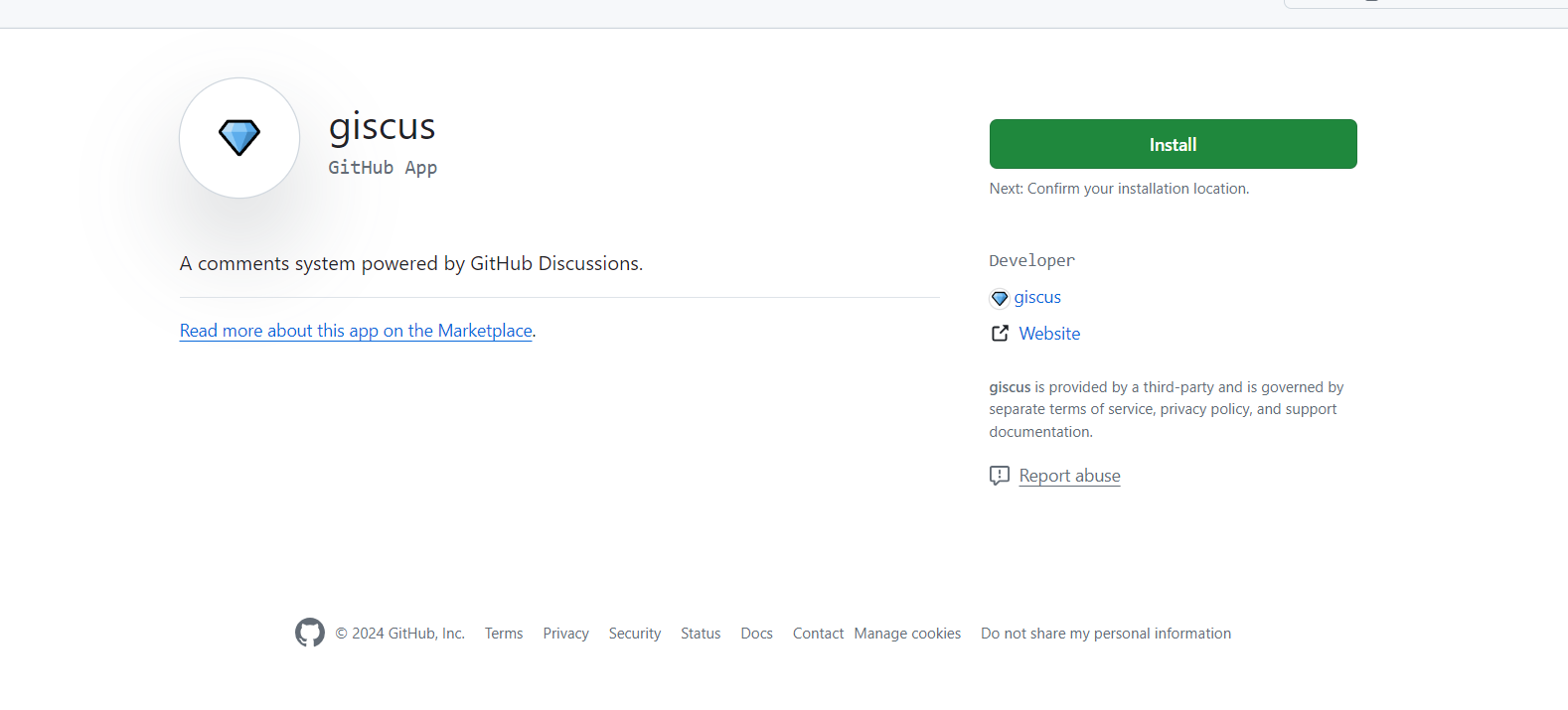
然后点击install,完成giscus 的安装,然后你就可以配置你的giscus给全部仓库开放,还是给部分仓库开放,也可以访问上面的传送门,重新配置
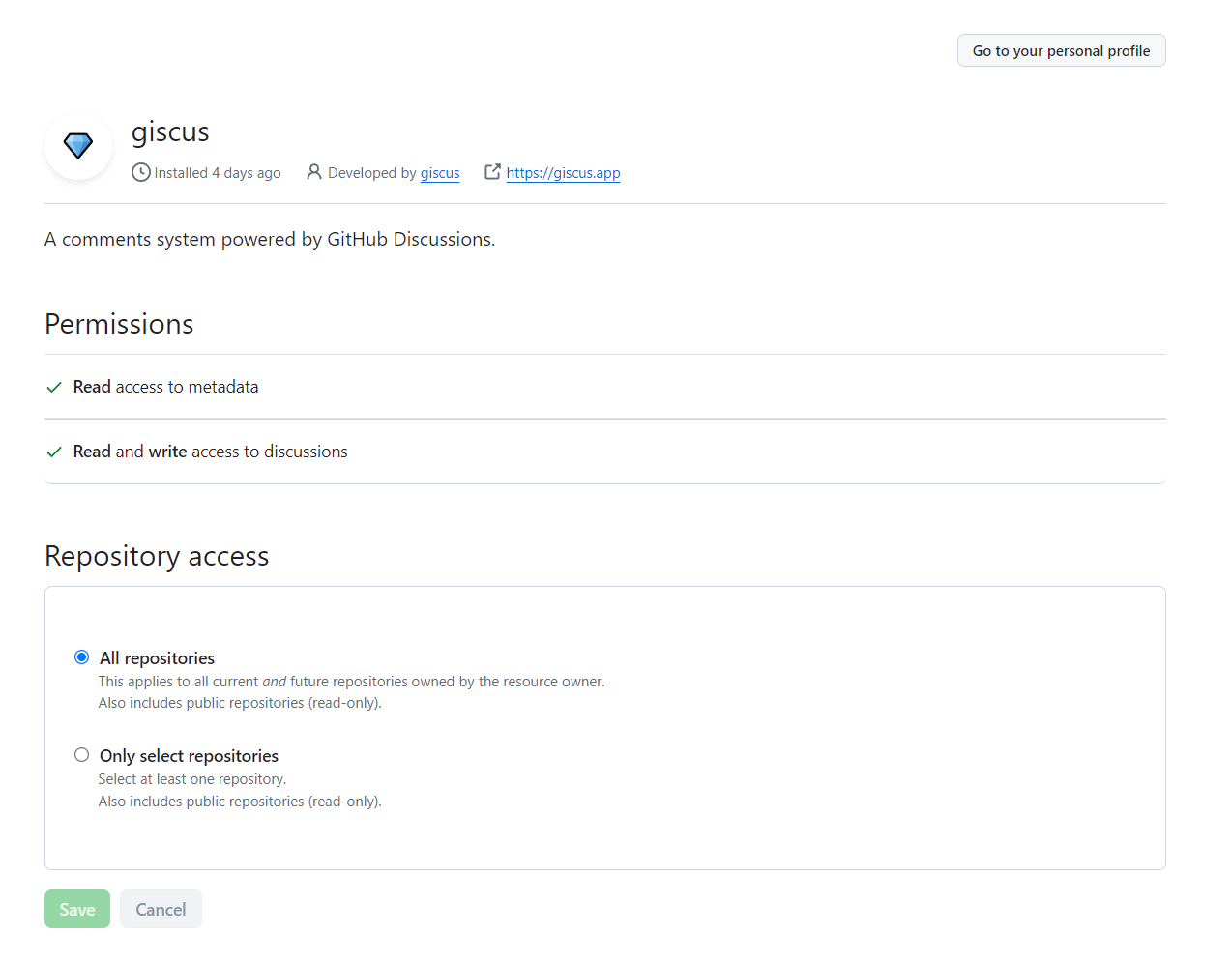
然后:访问Giscus的官网,生成一串snippet, 点击传送门
按照中文提示,填写你要配置Giscus的仓库
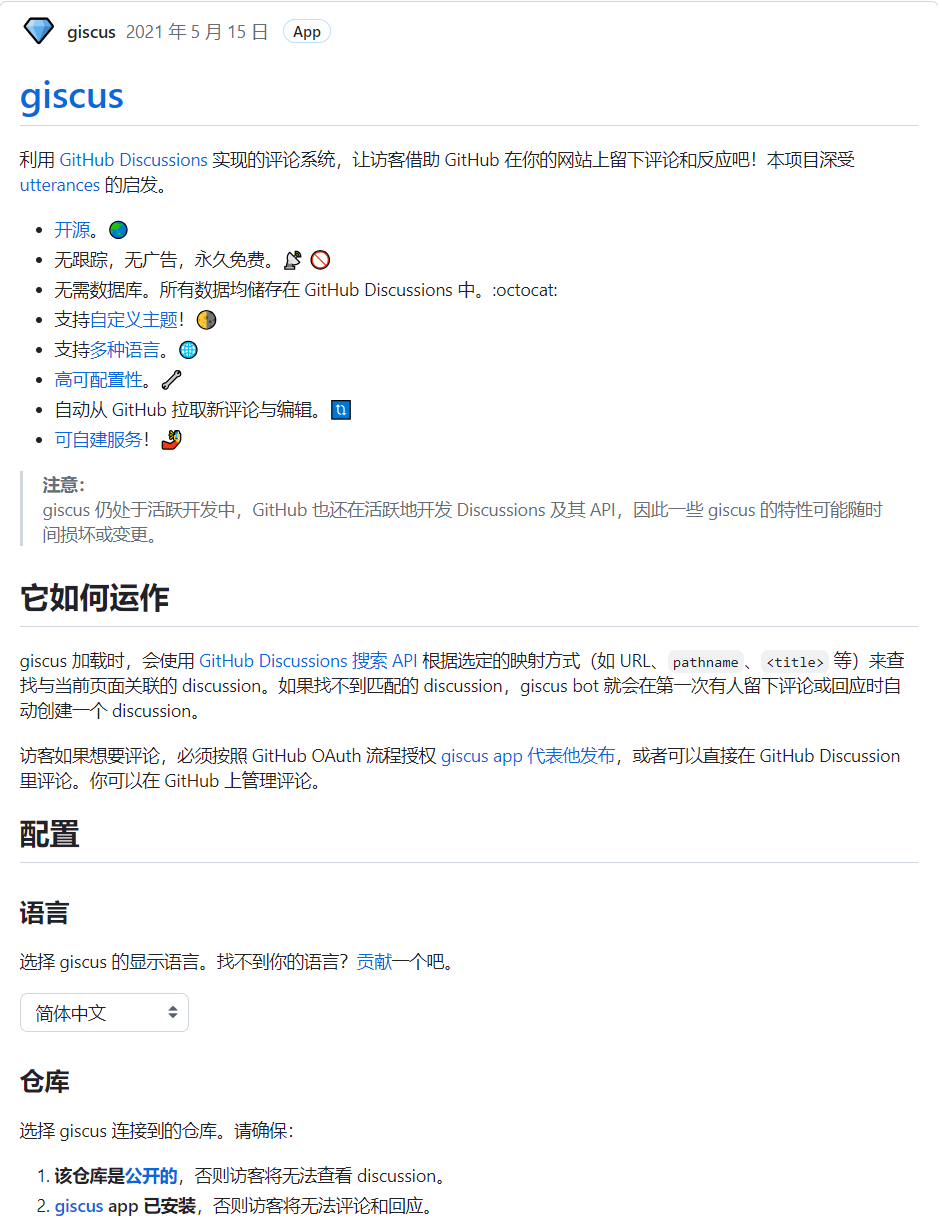
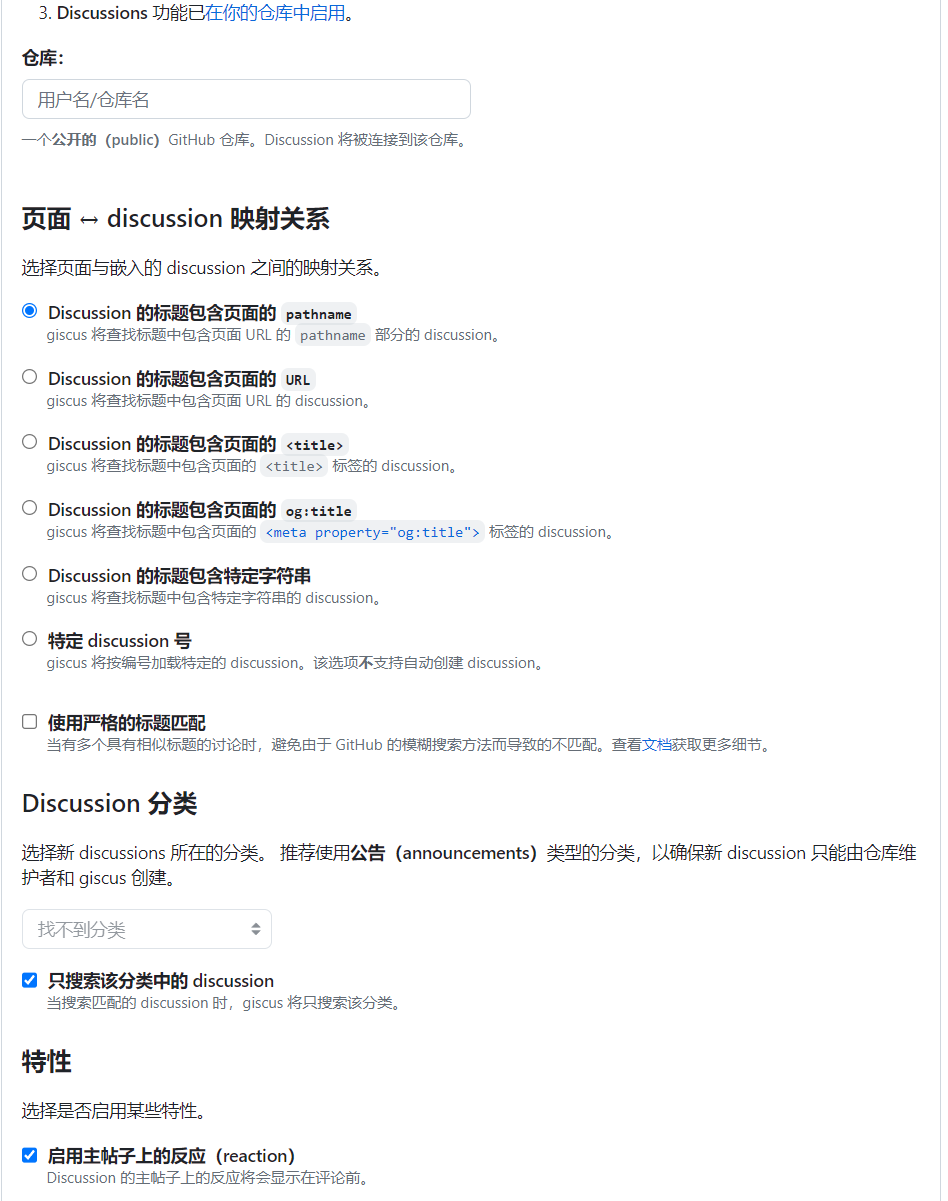
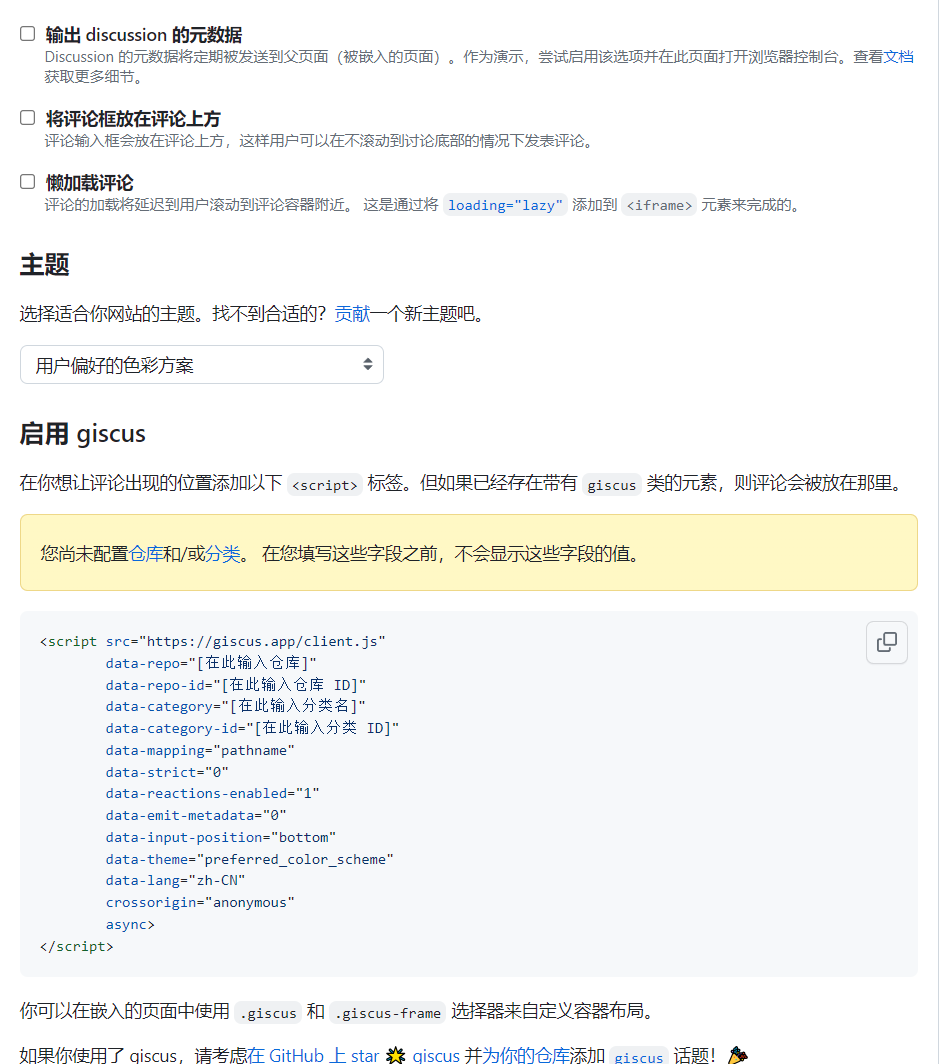
这样你就得到了属于你这个仓库的snippet
<script
src="https://giscus.app/client.js"
data-repo="<username>/<repository>"
data-repo-id="..."
data-category="..."
data-category-id="..."
data-mapping="pathname"
data-reactions-enabled="1"
data-emit-metadata="1"
data-theme="light"
data-lang="en"
crossorigin="anonymous"
async
>
</script>
然后将这个Snippet粘贴到你的comments.html就实现了Giscus的配置
{% if page.meta.comments %}
<h2 id="__comments">{{ lang.t("meta.comments") }}</h2>
<!-- Insert generated snippet here -->
<script
src="https://giscus.app/client.js"
data-repo="<username>/<repository>"
data-repo-id="..."
data-category="..."
data-category-id="..."
data-mapping="pathname"
data-reactions-enabled="1"
data-emit-metadata="1"
data-theme="light"
data-lang="en"
crossorigin="anonymous"
async
>
</script>
<!-- Synchronize Giscus theme with palette -->
<script>
var giscus = document.querySelector("script[src*=giscus]")
// Set palette on initial load
var palette = __md_get("__palette")
if (palette && typeof palette.color === "object") {
var theme = palette.color.scheme === "slate"
? "transparent_dark"
: "light"
// Instruct Giscus to set theme
giscus.setAttribute("data-theme", theme)
}
// Register event handlers after documented loaded
document.addEventListener("DOMContentLoaded", function() {
var ref = document.querySelector("[data-md-component=palette]")
ref.addEventListener("change", function() {
var palette = __md_get("__palette")
if (palette && typeof palette.color === "object") {
var theme = palette.color.scheme === "slate"
? "transparent_dark"
: "light"
// Instruct Giscus to change theme
var frame = document.querySelector(".giscus-frame")
frame.contentWindow.postMessage(
{ giscus: { setConfig: { theme } } },
"https://giscus.app"
)
}
})
})
</script>
{% endif %}
最后:在你的文章里配上标签¶
在你的文章头里面,配置以下内容:
---
comments: true
---
...
文章内容
然后本地启动服务,你就会发现在你的文章最下面,多了评论区
$ mkdocs serve

参考¶
material:adding-a-comment-system